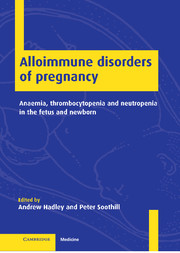 Alloimmune Disorders of Pregnancy
Alloimmune Disorders of Pregnancy Published online by Cambridge University Press: 26 October 2009
Introduction
With the established use of postnatal anti-D prophylaxis for D-negative women, together with its increasing use for routine antenatal prophylaxis, the incidence of sensitization to D has markedly fallen. This is reflected by the reduction in the overall number of cases of HDFN (Section 5.3.2). However, women with low anti-body levels or in their first sensitized pregnancies continue to be referred to tertiary fetal medicine units for specialized management. Considerable effort is, therefore, spent by fetal medicine specialists in monitoring the disease course, predicting its progression and deciding on the need and timing of intrauterine transfusions.
The most accurate test to assess the degree of fetal anaemia, and thus the need for transfusion, is direct fetal haemoglobin measurement by fetal blood sampling. However, cordocentesis can cause an increase in the antibody concentration and is associated with about a 1% fetal loss rate and so is not an appropriate first-line investigation. Fetal blood sampling is best reserved for cases where severe fetal anaemia is already suspected and so intrauterine transfusion is likely to follow. At amniocentesis, the needle is rarely passed transplacentally and, therefore, the risk of boosting the antibody level is less than with cordocentesis, although the procedure still has small but significant risks of causing miscarriage or preterm labour. In recent years, several noninvasive methods for the prediction of fetal anaemia have been assessed and these are now allowing the use of invasive testing to be deferred, usually until transfusion is necessary.
To save this book to your Kindle, first ensure [email protected] is added to your Approved Personal Document E-mail List under your Personal Document Settings on the Manage Your Content and Devices page of your Amazon account. Then enter the ‘name’ part of your Kindle email address below. Find out more about saving to your Kindle.
Note you can select to save to either the @free.kindle.com or @kindle.com variations. ‘@free.kindle.com’ emails are free but can only be saved to your device when it is connected to wi-fi. ‘@kindle.com’ emails can be delivered even when you are not connected to wi-fi, but note that service fees apply.
Find out more about the Kindle Personal Document Service.
To save content items to your account, please confirm that you agree to abide by our usage policies. If this is the first time you use this feature, you will be asked to authorise Cambridge Core to connect with your account. Find out more about saving content to Dropbox.
To save content items to your account, please confirm that you agree to abide by our usage policies. If this is the first time you use this feature, you will be asked to authorise Cambridge Core to connect with your account. Find out more about saving content to Google Drive.